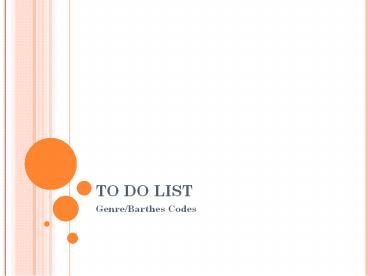Genre Evaluation - PowerPoint PPT Presentation
Title:
Genre Evaluation
Description:
Evaluation Question 4 – PowerPoint PPT presentation
Number of Views:21
Title: Genre Evaluation
1
TO DO LIST
- Genre/Barthes Codes
2
Generic Conventions of my Film
- Which Genre(s) does my film belong to?
- My film belongs to the crime/thriller genre
- Give examples of conventions of those genres I
followed? - Blood and murder was featured within it, black
and white filtering, costume follows convention,
the twist at the end of the film followed
thriller conventions, Props e.g. knives and guns
from crime. I followed the conventional plot a
lot as usually a lot of crime films are a
straight forward who done it with a twist
ending. - Which conventions did I NOT follow?
- By including typical conventions expected to be
seen inside that genre by the audience - How did I vary the generic conventions?
- My plot follows convention of the genre however
my style goes against genre convention a lot as
thrillers that are set in contemporary times
arent usually in black and white except for
movies such as Sin City which also challenges the
genre stereotype. We did this in the silent
scenes and during the flashbacks to put
voiceovers and music over them and differ them
from the scenes where the detectives are working.
3
Comparing and Contrasting My Film
- Comparing and contrasting my film to 3 examples
- The Usual Suspects, Prisoners, Out of the past
- Narrative structure It follows a twist at the
end like The Usual Suspects where the man they
were looking for was right under their nose the
whole time. - Plot The plot of our films follows a classic who
done it - Themes friendship, mystery. Much like the themes
of Prisoners. - Characters Classic Good Cop/Bad cop characters
like those in most crime dramas. - Setting/mise-en-scene A police station, like Out
of the Past and The Usual Suspects - Cinematography/Editing (for example, types of
shot, pace, transitions, music) Voice over in
black and white explaining thoughts of a
detective with music
4
BARTHES CODE
- The Hermeneutic Code (HER)
- The Hermeneutic Code refers to any element of the
story that is not fully explained and hence
becomes a mystery to the reader. - The full truth is often avoided, for example in
- Snares deliberately avoiding the truth.
- Equivocations partial or incomplete answers.
- Jamming's openly acknowledge that there is no
answer to a problem. - The purpose of the author in this is typically to
keep the audience guessing, arresting the enigma,
until the final scenes when all is revealed and
all loose ends are tied off and closure is
achieved. - The Proairetic Code (ACT)
- The Proairetic Code also builds tension,
referring to any other action or event that
indicates something else is going to happen, and
which hence gets the reader guessing as to what
will happen next. - The Hermeneutic and Proairetic Codes work as a
pair to develop the story's tensions and keep the
reader interested. Barthes described them as - "...dependent on ... two sequential codes the
revelation of truth and the coordination of the
actions represented there is the same constraint
in the gradual order of melody and in the equally
gradual order of the narrative sequence." - The Semantic Code (SEM)
- This code refers to connotation within the story
that gives additional meaning over the basic
denotative meaning of the word. - It is by the use of extended meaning that can be
applied to words that authors can paint rich
pictures with relatively limited text and the way
they do this is a common indication of their
writing skills. - The Symbolic Code (SYM)
- This is very similar to the Semantic Code, but
acts at a wider level, organizing semantic
meanings into broader and deeper sets of meaning.
- This is typically done in the use of antithesis,
where new meaning arises out of opposing and
conflict ideas. - The Cultural Code (REF)
- This code refers to anything that is founded on
some kind of canonical works that cannot be
challenged and is assumed to be a foundation for
truth.
5
Barthes Codes
- Applying Barthes Codes to my film
- For example, how did I create expectation?
(enigma) As we followed typical convention that
most people already recognise in crime dramas it
wasnt a huge surprise when his partner turned
out to be the murderer. However, we used shots
that suggested his partner could be the murderer
as he was always watching him and he was always
there. - How did I build suspense (action enigma etc) We
built suspense through having long shots that
focused on something suspicious, for example, in
Scene 3 I recorded a shot from behind the
antagonist that then focused onto the protagonist
and back onto the antagonist. This created
suspense as it seemed like the antagonist was
watching over the detective and trying to cover
his tracks.
6
Genre as a Concept
- Do you think genre is a useful concept to apply
to your short film? Yes, it gives a basic outline
for your film to follow and helps achieve what
audiences expect from that genre. - Rigidity (not set in stone- hybridity and change)
It doesnt follow every convention with that
genre and can be described as a crime
drama/thriller as it takes conventions from both
different genres such as a montage which are
commonly seen within crime dramas and also using
action within the final scene which is common
within Thrillers. - Commercial (audiences depend on recognition but
is this as important for a short film?) Most
people dont watch short films and when they do
the film is too short to completely follow
convention. It wouldnt be uncommon for a film
set for one audience and inside one genre using
different conventions of other genres or even
being a hybrid film altogether.































